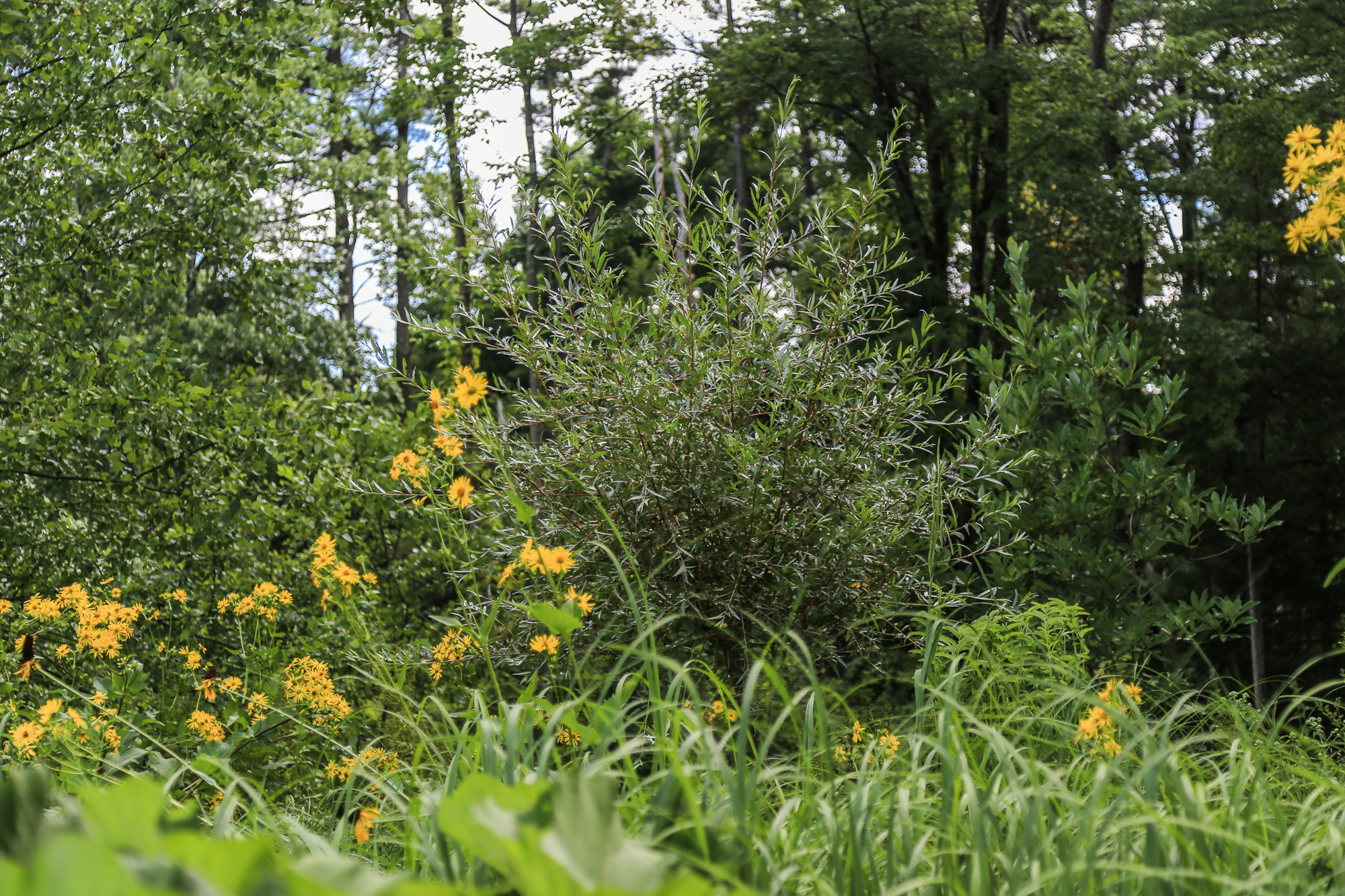High Summer
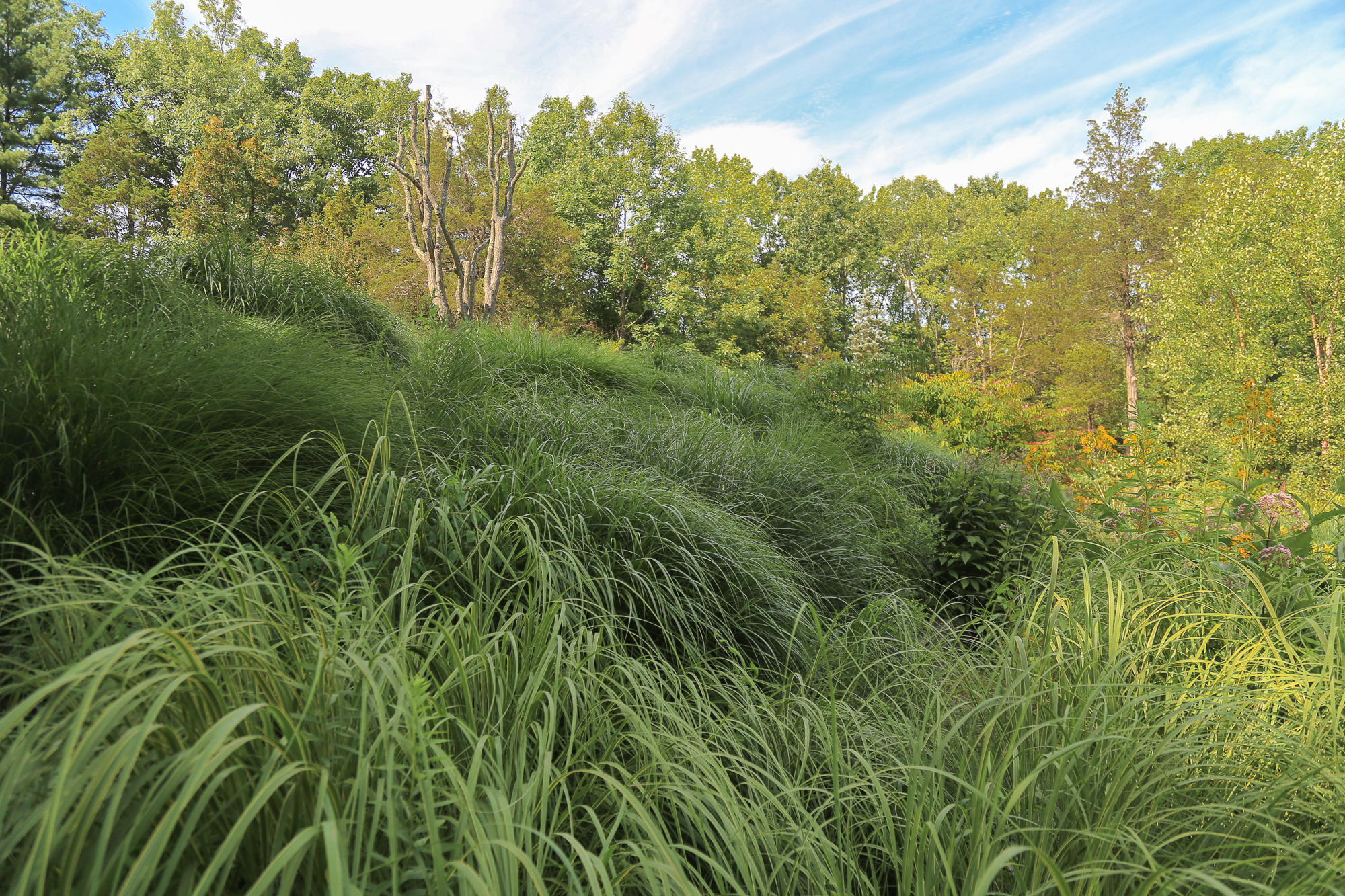 It's late July and I haven't posted on the garden's progress for over six weeks. So much for my garden diary ... After a drought of several weeks, we've had a long period of frequent, often violent, thunderstorms with torrential rains, mostly lasting only 20 or 30 minutes, but certainly stressful for my structural perennials and grasses. So different from those light mists and showers I remember in England last summer. Another reason why American gardens are different from English gardens, I suppose.
It's late July and I haven't posted on the garden's progress for over six weeks. So much for my garden diary ... After a drought of several weeks, we've had a long period of frequent, often violent, thunderstorms with torrential rains, mostly lasting only 20 or 30 minutes, but certainly stressful for my structural perennials and grasses. So different from those light mists and showers I remember in England last summer. Another reason why American gardens are different from English gardens, I suppose.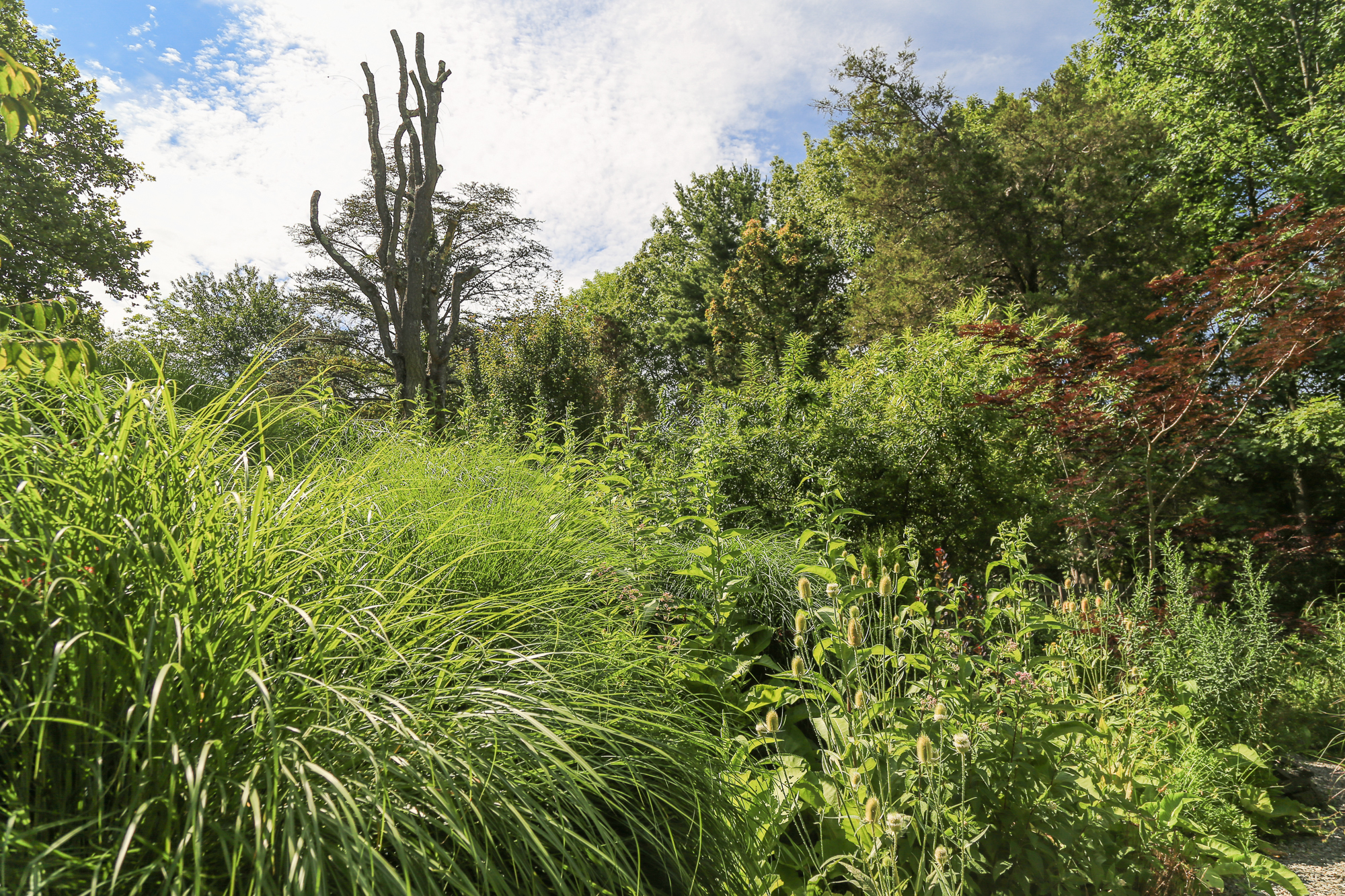 Perhaps another reason, cultural and practical, American gardens differ from English gardens--snags. We give the name "snag" to standing dead trees and leave them up for the many woodpeckers living in the woods, and as homes for smaller living things. This one, dominating the top of the bank near the house, isn't your usual snag. It's rather baroque, having begun life as a weeping Japanese cherry half a century ago when the house was built. A line of tall Inula racemosa appears to be marching from it down the hill and gathering with a bunch of prickly teasels at the base.
Perhaps another reason, cultural and practical, American gardens differ from English gardens--snags. We give the name "snag" to standing dead trees and leave them up for the many woodpeckers living in the woods, and as homes for smaller living things. This one, dominating the top of the bank near the house, isn't your usual snag. It's rather baroque, having begun life as a weeping Japanese cherry half a century ago when the house was built. A line of tall Inula racemosa appears to be marching from it down the hill and gathering with a bunch of prickly teasels at the base.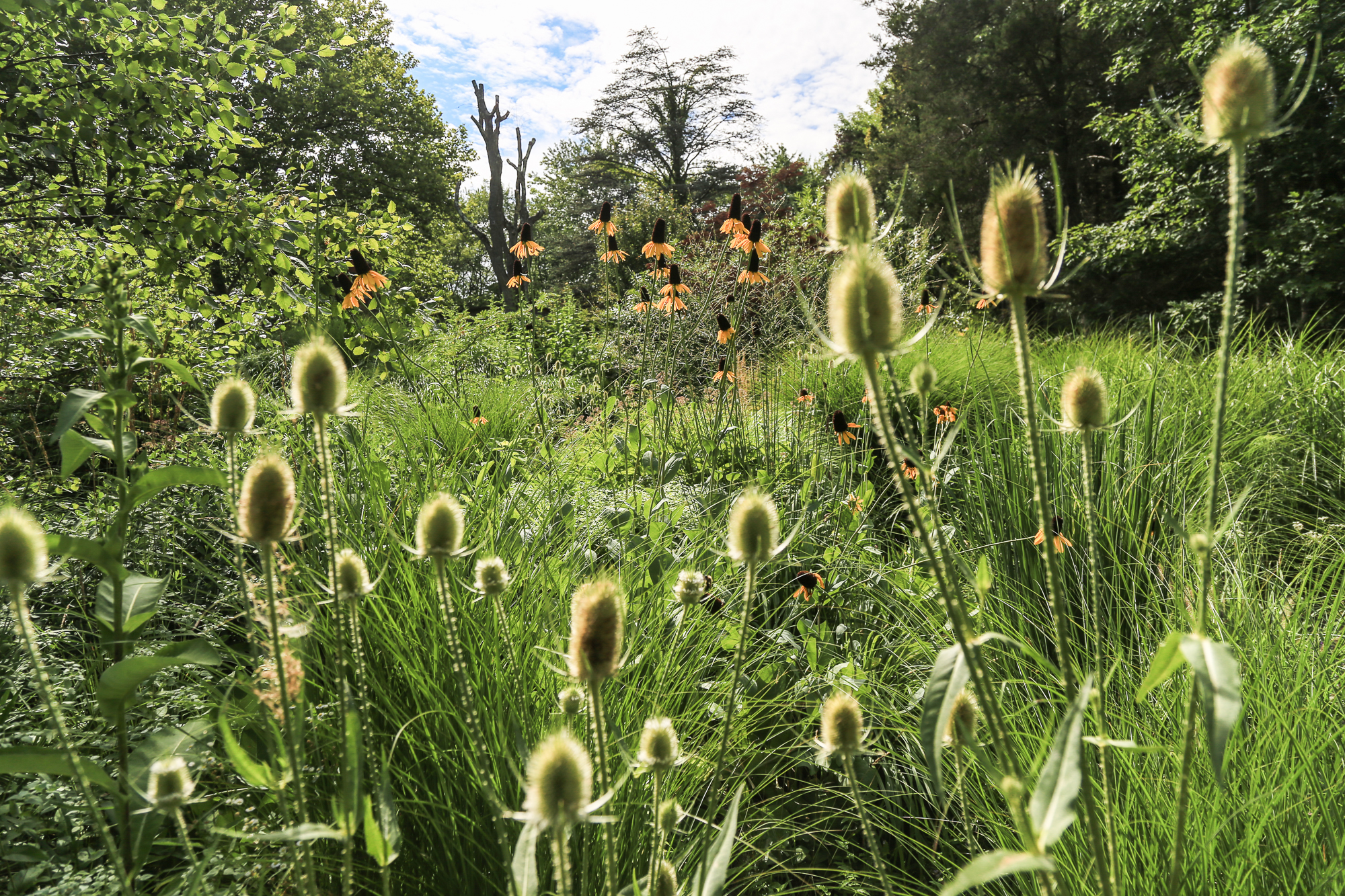 Apart from its dominant sculptural form, the snag has a candelabra-esque shape that echoes many of the vertical plant structures in the garden below.
Apart from its dominant sculptural form, the snag has a candelabra-esque shape that echoes many of the vertical plant structures in the garden below. I think you can see conditions are stressful. The day I took this photo the temperature was well above 90 and humidity was high. There's plenty of water from those thunderstorms, so plants are growing fast. Many tall plants are teetering on tip-toe, as if daring a stormy gust to push them over. It will happen, really already has to some extent. The Silphiums are flowering robustly this year, so are top heavy and want to lean this way and that. I leave them to it except where they block the paths.
I think you can see conditions are stressful. The day I took this photo the temperature was well above 90 and humidity was high. There's plenty of water from those thunderstorms, so plants are growing fast. Many tall plants are teetering on tip-toe, as if daring a stormy gust to push them over. It will happen, really already has to some extent. The Silphiums are flowering robustly this year, so are top heavy and want to lean this way and that. I leave them to it except where they block the paths.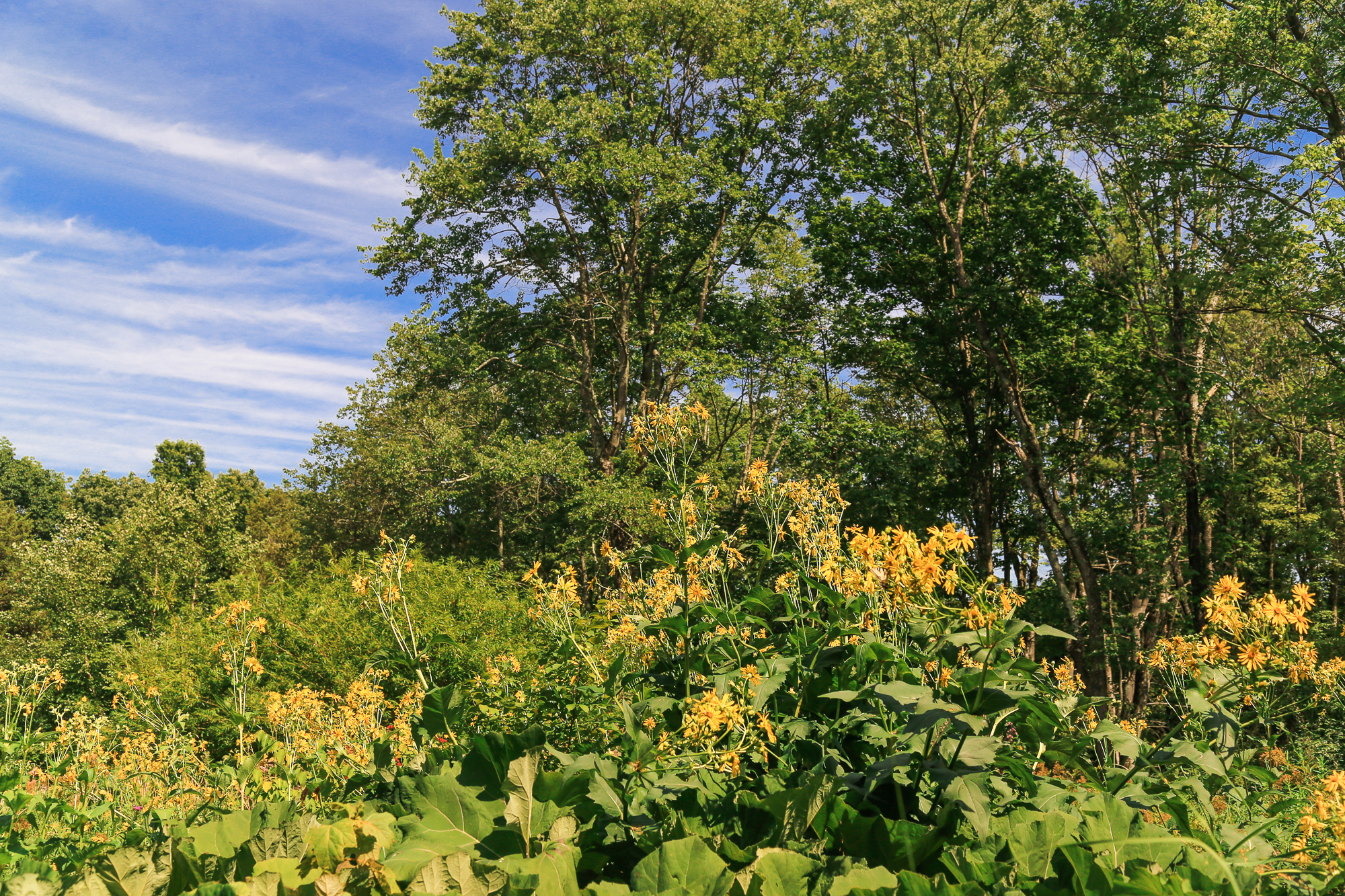 I hate staking and am considering just cutting many of them out, though I'll probably work out a compromise.
I hate staking and am considering just cutting many of them out, though I'll probably work out a compromise.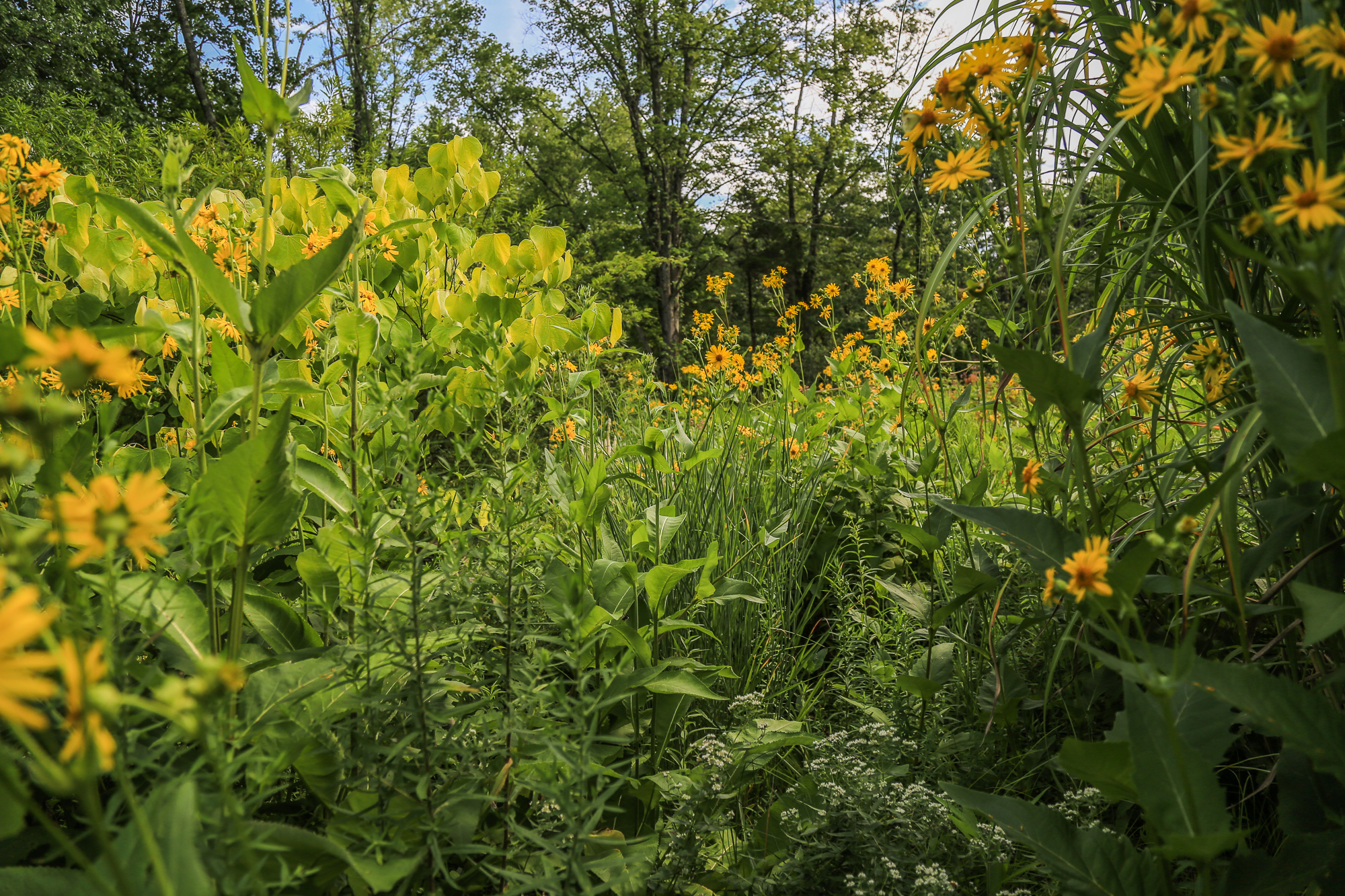 Of the three Silphiums in my garden--perfoliatum, laciniatum, terebinthinaceum--the latter two are my favorites. They flower less robustly and, more important, their forms and structures add a magical effect--the extremely tall, leaning laciniatum (below) with its giant lacy, deeply cut foliage, and terebinthinaceum, with slim, elegant, leafless flower stalks topped by tight, hard green buds, and with huge spade-shaped basal leaves.
Of the three Silphiums in my garden--perfoliatum, laciniatum, terebinthinaceum--the latter two are my favorites. They flower less robustly and, more important, their forms and structures add a magical effect--the extremely tall, leaning laciniatum (below) with its giant lacy, deeply cut foliage, and terebinthinaceum, with slim, elegant, leafless flower stalks topped by tight, hard green buds, and with huge spade-shaped basal leaves.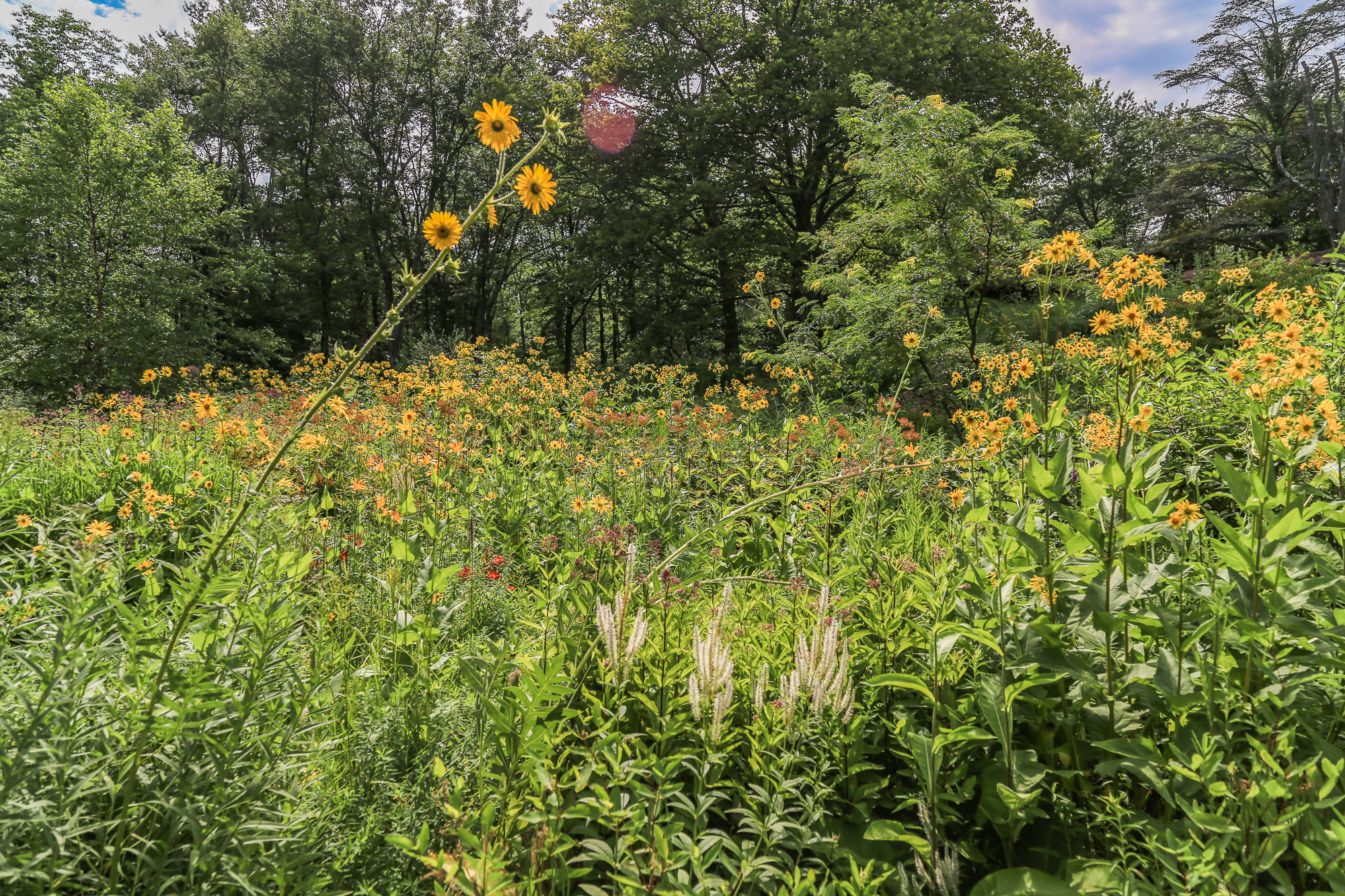 And note the white Veronicastrum virginicum. It's proving itself to be vigorous enough to compete successfully in the tightly planted garden. It's taken me years to see this, and now I want to add more colonies to increase diversity and visual pleasure.
And note the white Veronicastrum virginicum. It's proving itself to be vigorous enough to compete successfully in the tightly planted garden. It's taken me years to see this, and now I want to add more colonies to increase diversity and visual pleasure.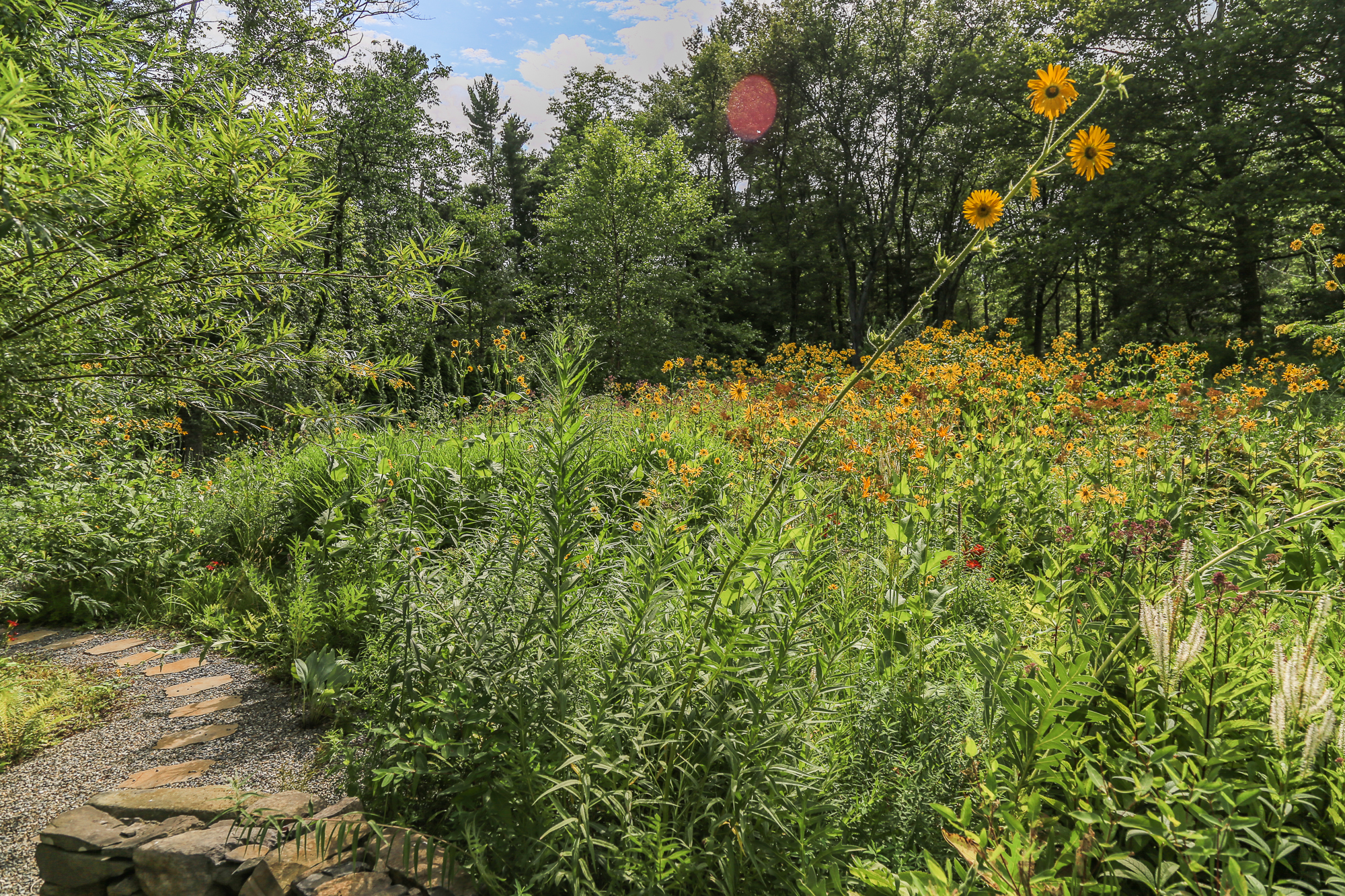 Not all the tall yellows are Silphiums. I have a lot of Rudbeckia maxima (and Inula racemosa 'Sonnenspeer', but that comes later). I'll admit--in case you haven't guessed--that yellow isn't my favorite color. But the ecology of my site gives me very narrow choices and it happens that these yellow-flowering behemoths are what thrive here. So, in compensation, I enjoy the structures and forms of the plants. The flowers, after all, soon fade and change into seed pods that offer far more interest, as you can see with the Rudbeckia, which as a bonus has glaucous blue foliage and a Dr. Seussian form that always delights.
Not all the tall yellows are Silphiums. I have a lot of Rudbeckia maxima (and Inula racemosa 'Sonnenspeer', but that comes later). I'll admit--in case you haven't guessed--that yellow isn't my favorite color. But the ecology of my site gives me very narrow choices and it happens that these yellow-flowering behemoths are what thrive here. So, in compensation, I enjoy the structures and forms of the plants. The flowers, after all, soon fade and change into seed pods that offer far more interest, as you can see with the Rudbeckia, which as a bonus has glaucous blue foliage and a Dr. Seussian form that always delights. But in late July, the yellow flowers are so profuse I often seek out parts of the garden with silent green space and other kinds of interest, somewhere I can put distance between me and the yellow cacophony, think about how to introduce clay-tolerant plants in other colors, but with vigor similar to the large Silphiums (there are few) ...
But in late July, the yellow flowers are so profuse I often seek out parts of the garden with silent green space and other kinds of interest, somewhere I can put distance between me and the yellow cacophony, think about how to introduce clay-tolerant plants in other colors, but with vigor similar to the large Silphiums (there are few) ...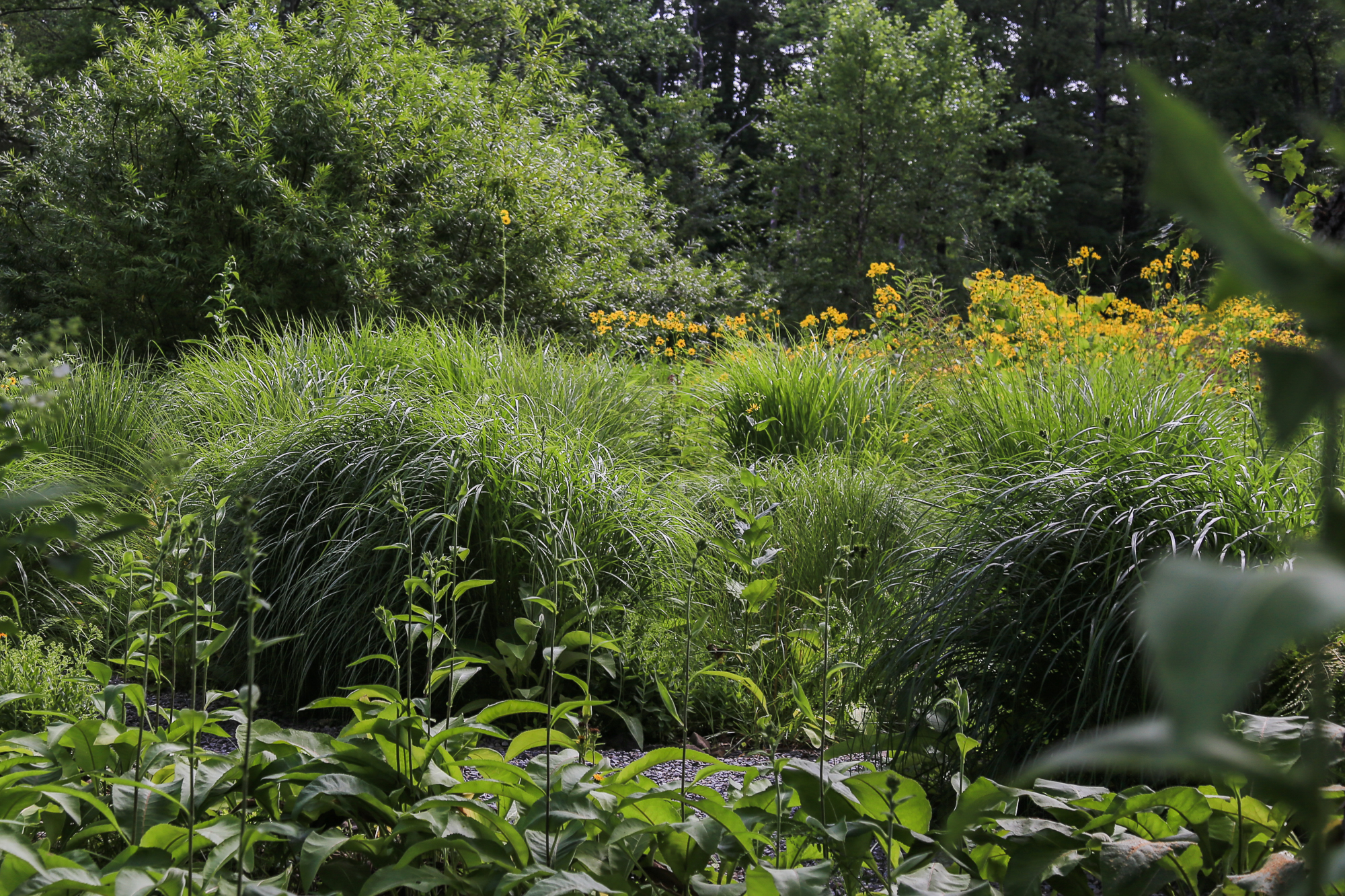 ... quieter areas like these banks of green grasses ...
... quieter areas like these banks of green grasses ... ... this plain of Petasites below the house ...
... this plain of Petasites below the house ... ... the path I humorously call "the outer circumferential walk" ...
... the path I humorously call "the outer circumferential walk" ...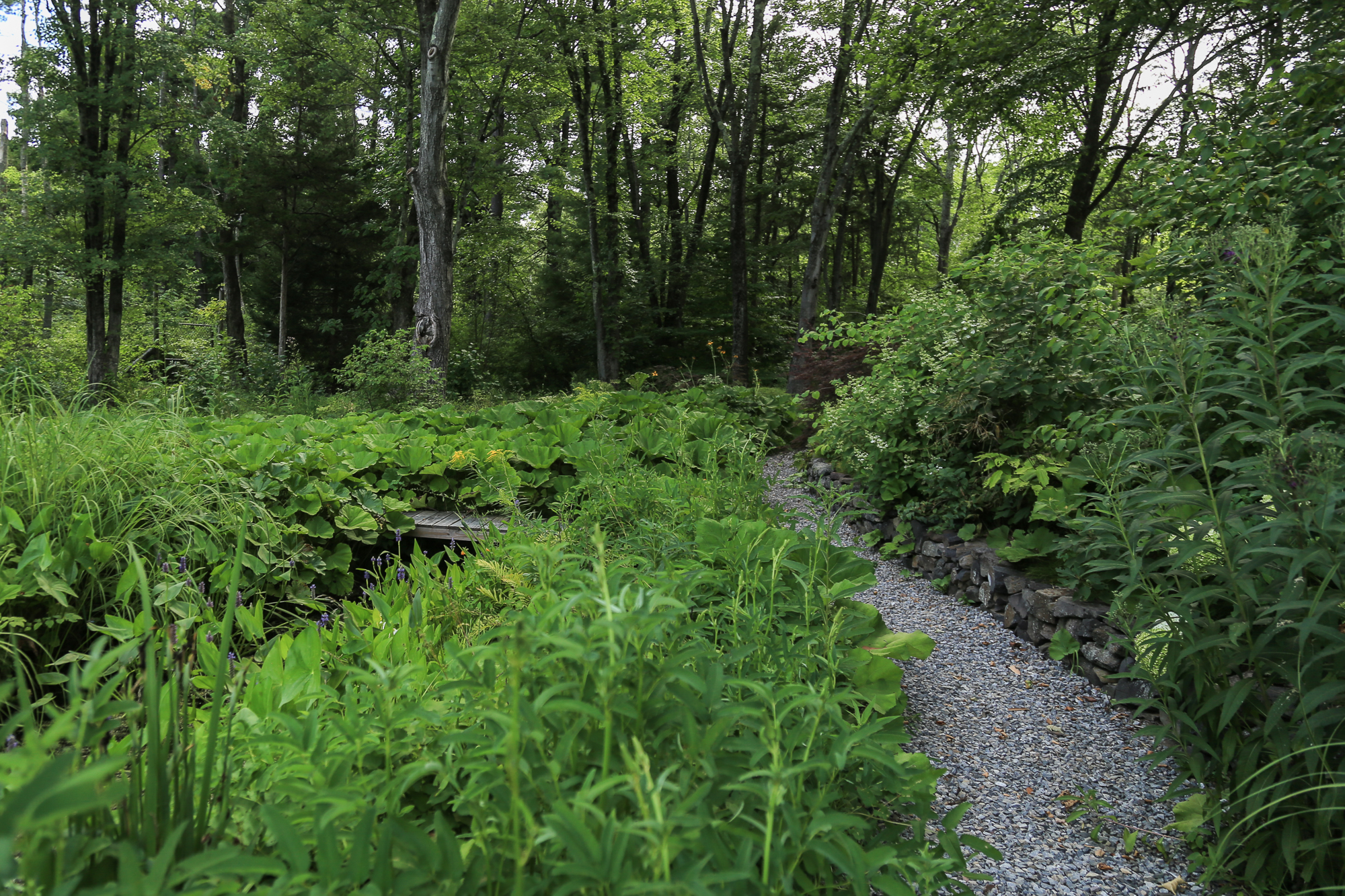 ... the path by the canal pond ...
... the path by the canal pond ...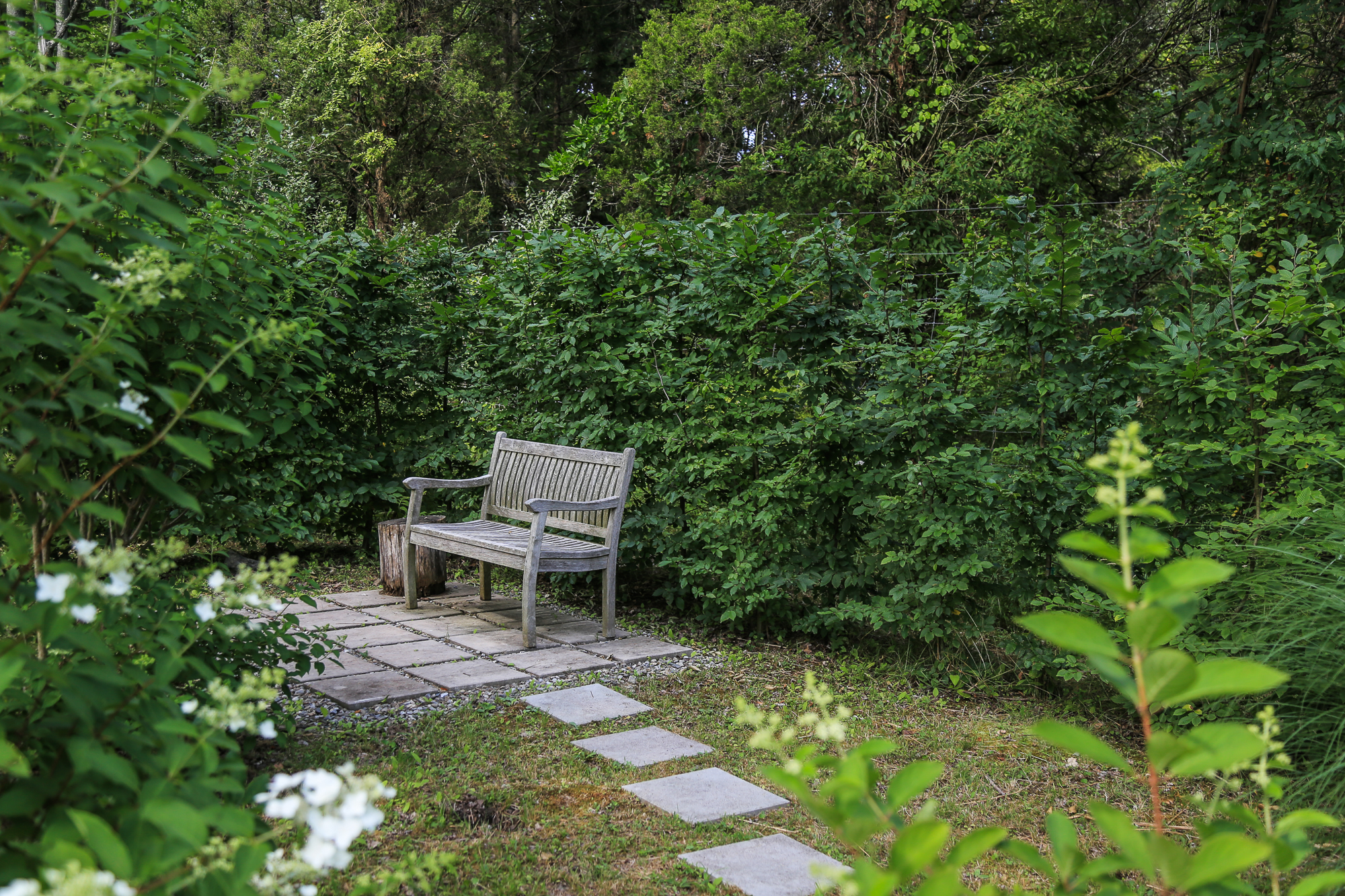 ... or the Carpinus Corner ...
... or the Carpinus Corner ...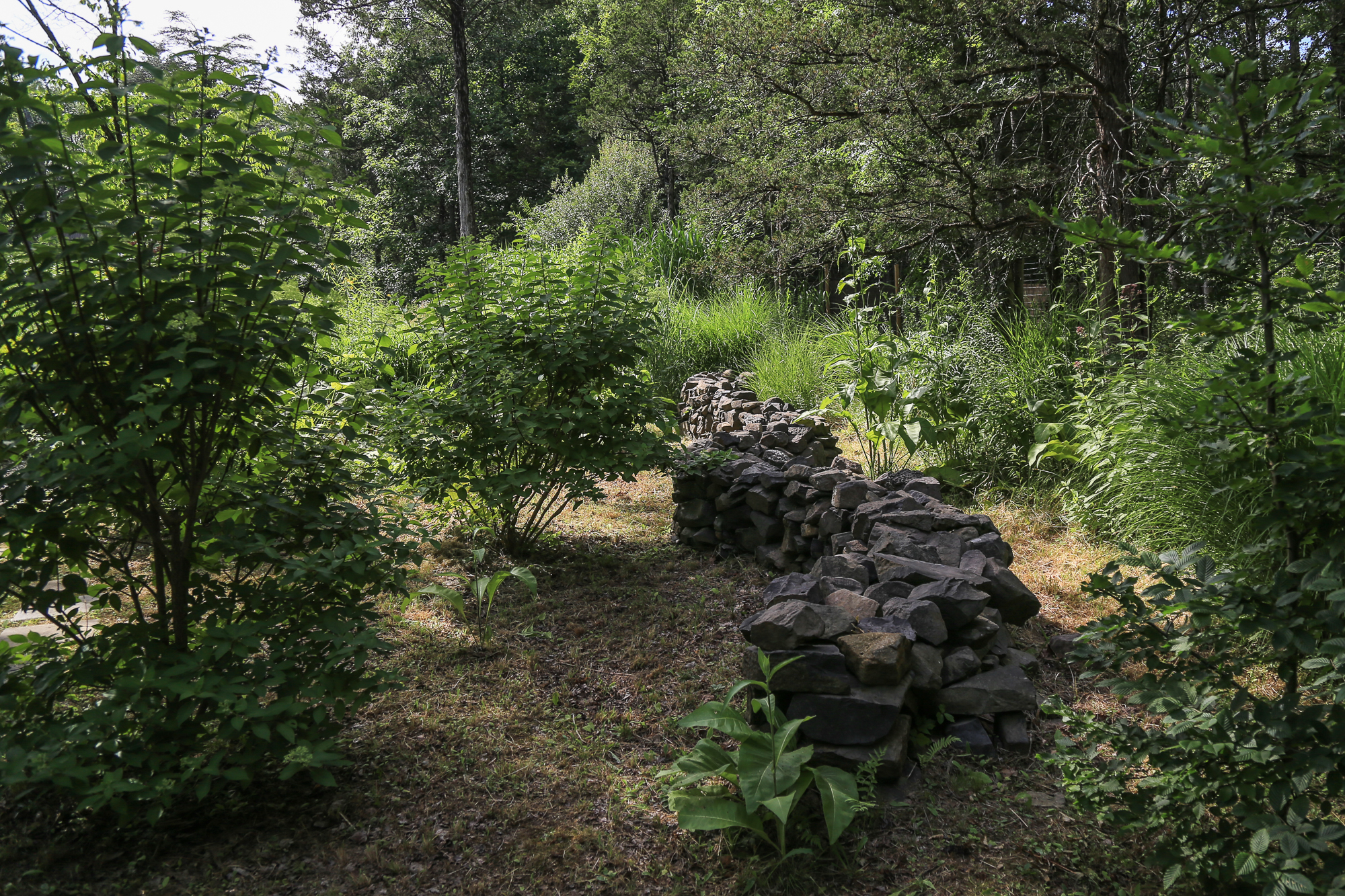 ... and its serpentine wall.
... and its serpentine wall. For another experience entirely, I can walk the Immersion Path, which cuts across the middle of the garden and, on cool days, makes a private, almost invisible place to sit and talk.
For another experience entirely, I can walk the Immersion Path, which cuts across the middle of the garden and, on cool days, makes a private, almost invisible place to sit and talk.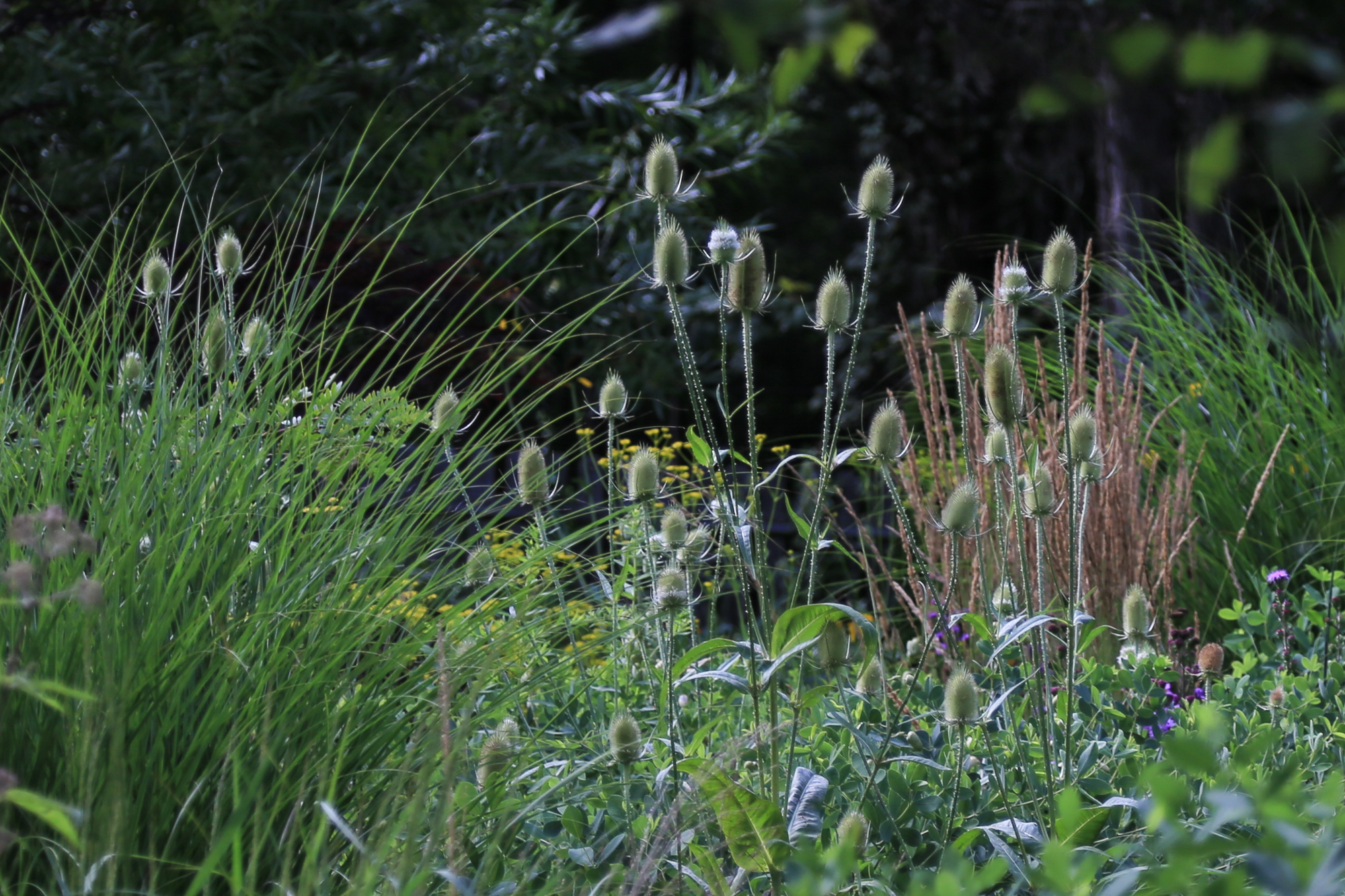 But there are wildlings and other things to provide diversion from the yellows too. Here teasel (Dipsacus fullonum) adds its prickly character until I have to pull it out in August (so as not to have several million teasels next year). I do leave one or two small plants to keep the biennial supply going.
But there are wildlings and other things to provide diversion from the yellows too. Here teasel (Dipsacus fullonum) adds its prickly character until I have to pull it out in August (so as not to have several million teasels next year). I do leave one or two small plants to keep the biennial supply going. Pycnanthemum is a tough plant and powerful insect attractor, and it gives the span of the garden a sparkle nothing else can. On hot days they buzz with hundreds of bees and other pollinators. Its most striking features are the silver foliage and fragrant white blossoms that cover the plants from early summer on. I have several--muticum, flexuosum, tenuifolium; really, I'm not sure which is which. There are marked differences in form and flower. (I could use an expert.)
Pycnanthemum is a tough plant and powerful insect attractor, and it gives the span of the garden a sparkle nothing else can. On hot days they buzz with hundreds of bees and other pollinators. Its most striking features are the silver foliage and fragrant white blossoms that cover the plants from early summer on. I have several--muticum, flexuosum, tenuifolium; really, I'm not sure which is which. There are marked differences in form and flower. (I could use an expert.)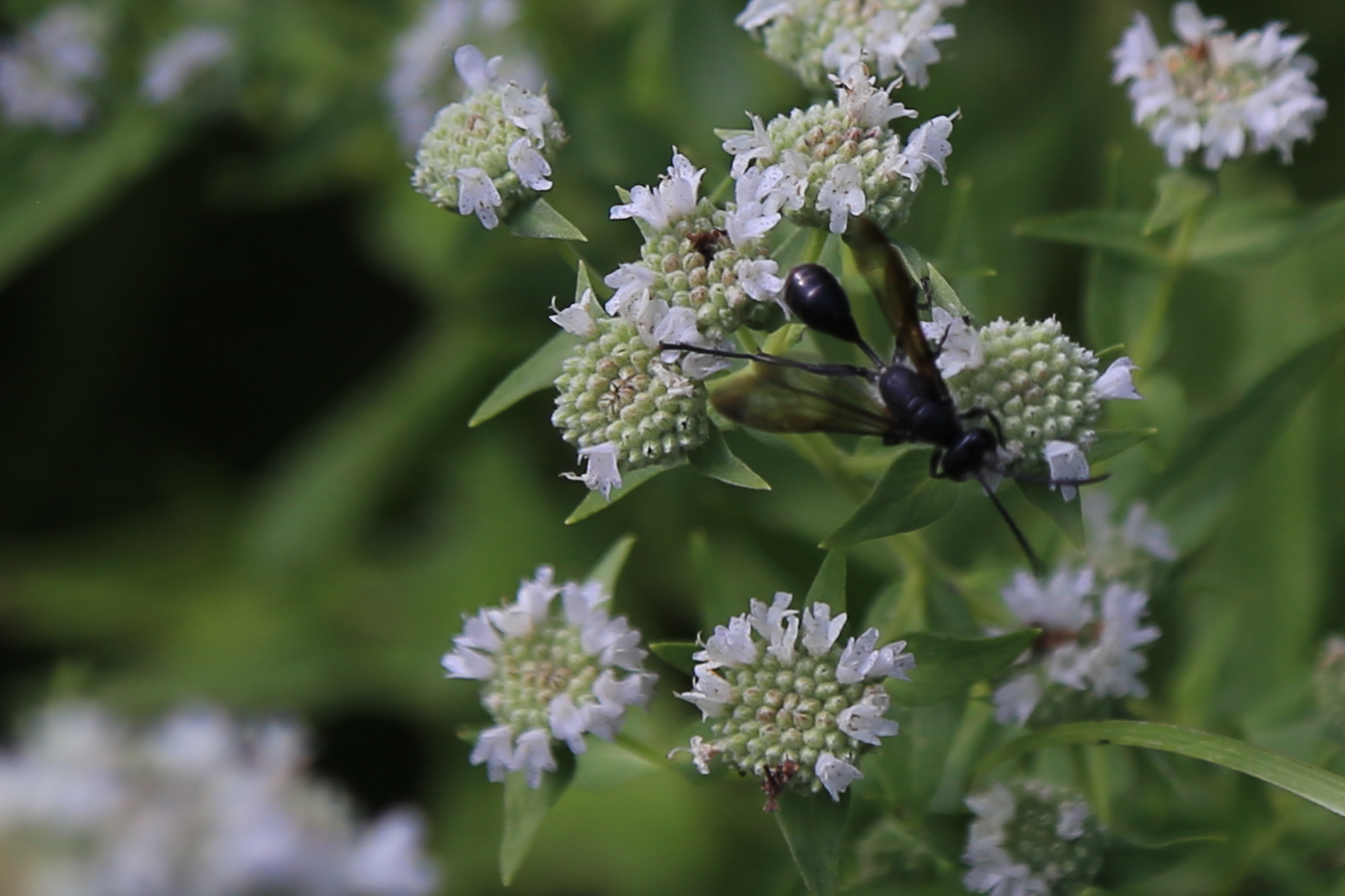 Joe Pye Weed (Eupatorium, now Eutrochium) helps balance the yellows and I'm constantly on the look out for those with deeper, more saturated purples and mauves. I've seen 'Riesenschirm' being used in UK and Dutch gardens for years ...
Joe Pye Weed (Eupatorium, now Eutrochium) helps balance the yellows and I'm constantly on the look out for those with deeper, more saturated purples and mauves. I've seen 'Riesenschirm' being used in UK and Dutch gardens for years ...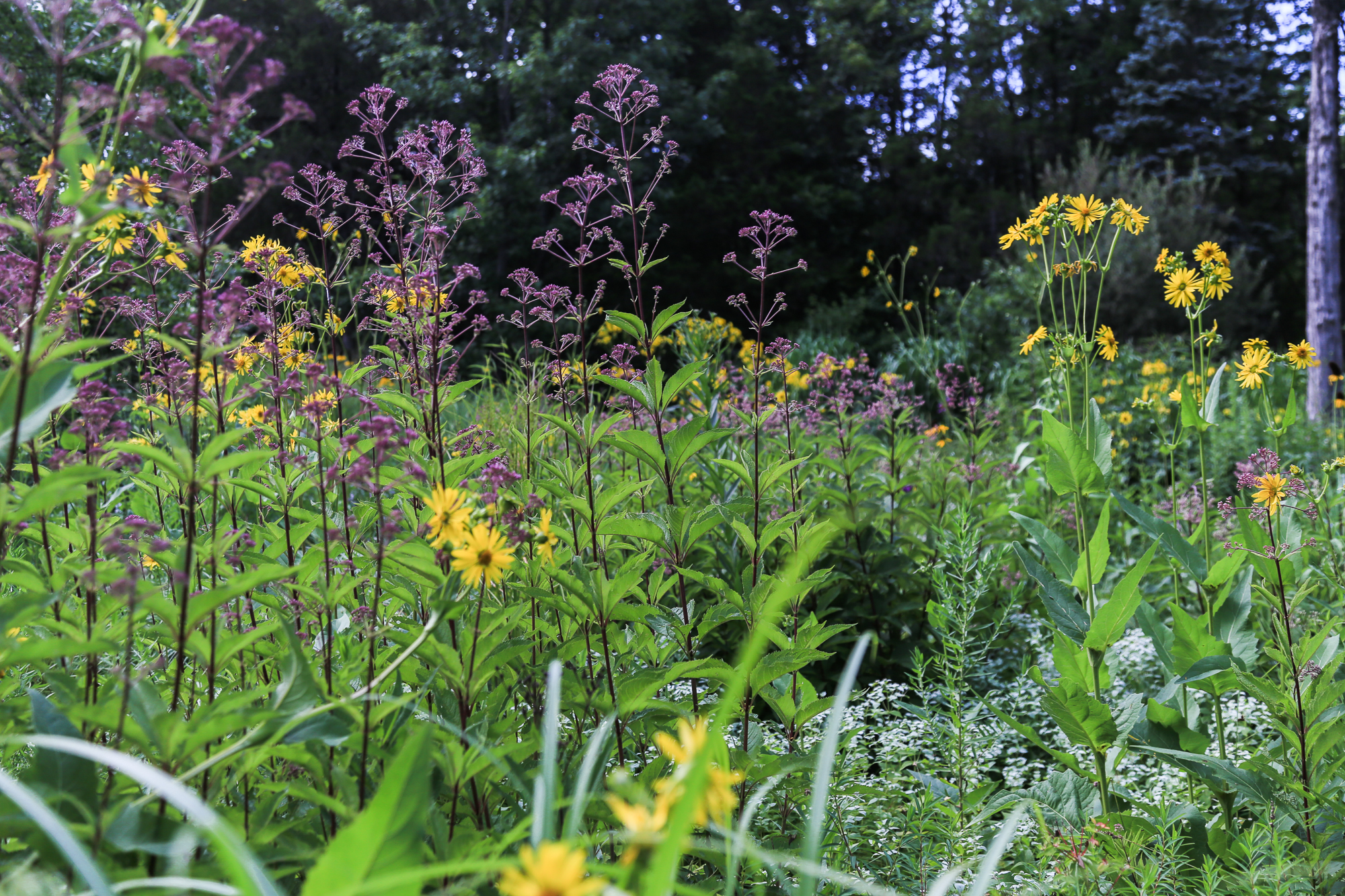 ...but it's almost impossible to find in the US, other than from a select few mail order nurseries. (I did get a few from Digging Dog, a blessedly wonderful nursery, though it's unfortunately 3000 miles away from me and shipping costs are high.) Here I could easily go on a rant about the poor selection of plants available from commercial American nurseries in general, but I won't. I'll let it go with saying we have an extremely limited range of plants available at local nurseries. (I don't include the many, large wholesale nurseries that provide an astounding array of plug plants for garden designers. They're great, but the highly competitive conditions in my garden call for large plants if they are to survive.)
...but it's almost impossible to find in the US, other than from a select few mail order nurseries. (I did get a few from Digging Dog, a blessedly wonderful nursery, though it's unfortunately 3000 miles away from me and shipping costs are high.) Here I could easily go on a rant about the poor selection of plants available from commercial American nurseries in general, but I won't. I'll let it go with saying we have an extremely limited range of plants available at local nurseries. (I don't include the many, large wholesale nurseries that provide an astounding array of plug plants for garden designers. They're great, but the highly competitive conditions in my garden call for large plants if they are to survive.)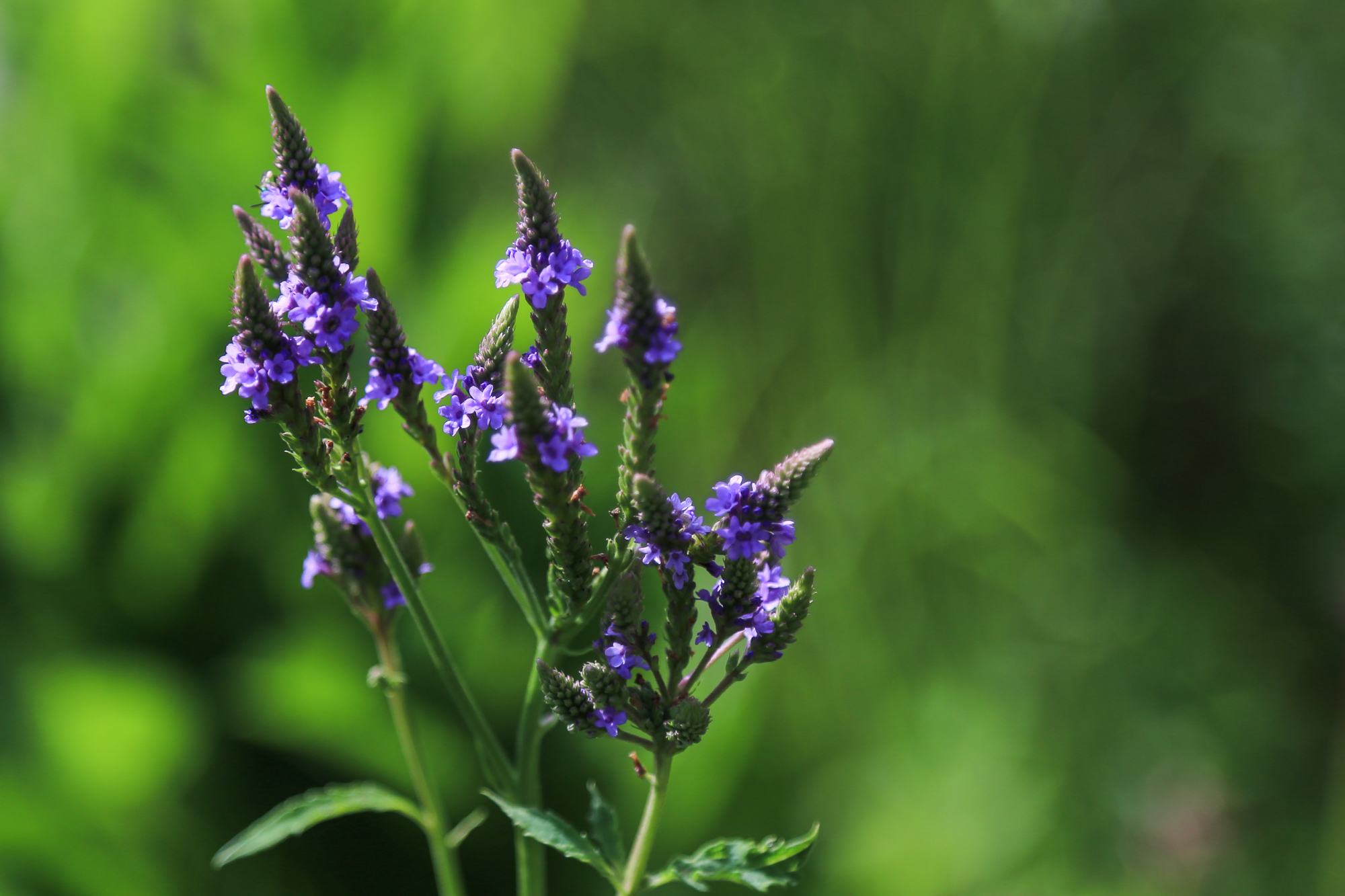 Even this native, the short-lived Verbena hastata, is difficult to find in nurseries. I got it at a special local nursery, Paxson Hill Farm, which offers many plants I'd never find in surrounding commercial nurseries. (I make regular visits there.) I'd like to have many more, but I'll have to rely on seed, which I'll order from a native seed supplier and broadcast this autumn.
Even this native, the short-lived Verbena hastata, is difficult to find in nurseries. I got it at a special local nursery, Paxson Hill Farm, which offers many plants I'd never find in surrounding commercial nurseries. (I make regular visits there.) I'd like to have many more, but I'll have to rely on seed, which I'll order from a native seed supplier and broadcast this autumn.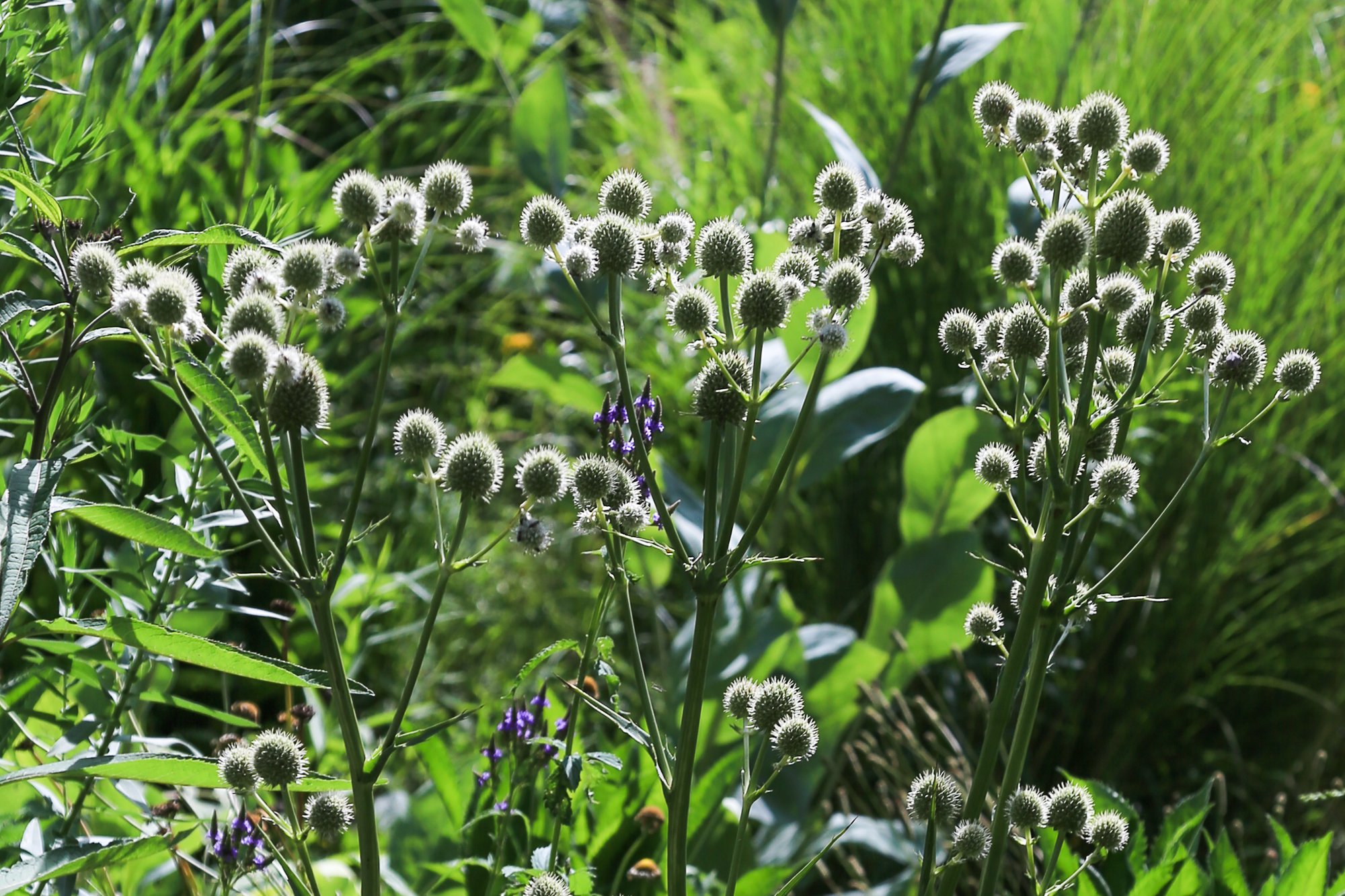 Also a mail-order plant, Eryngium yuccafolium (Rattlesnake Master), a native ...
Also a mail-order plant, Eryngium yuccafolium (Rattlesnake Master), a native ...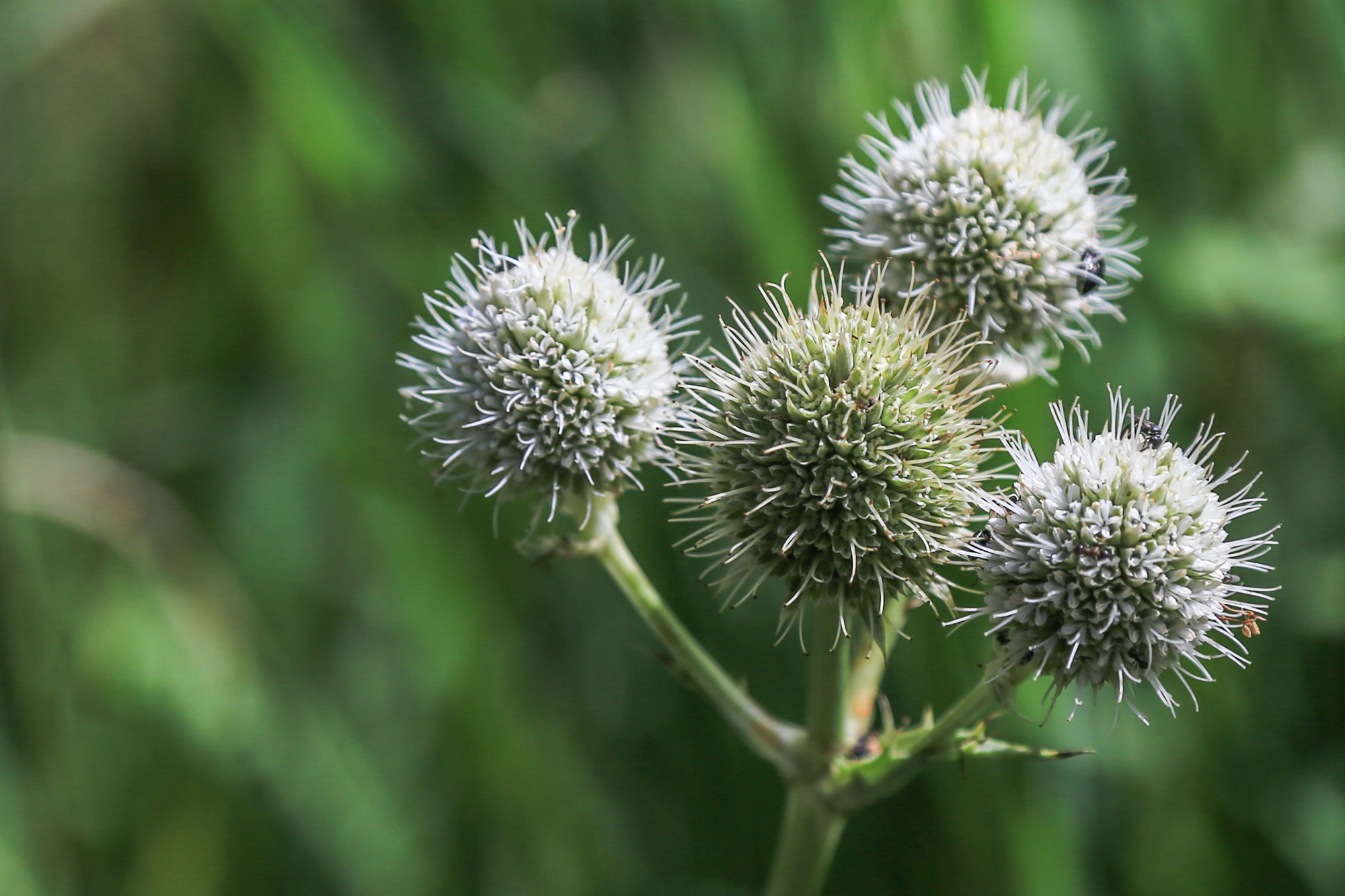 ... seems at home here and is seeding itself about year by year. It's a nice partner to the Pycnanthemums, so I hope it will develop into thickly growing colonies.
... seems at home here and is seeding itself about year by year. It's a nice partner to the Pycnanthemums, so I hope it will develop into thickly growing colonies.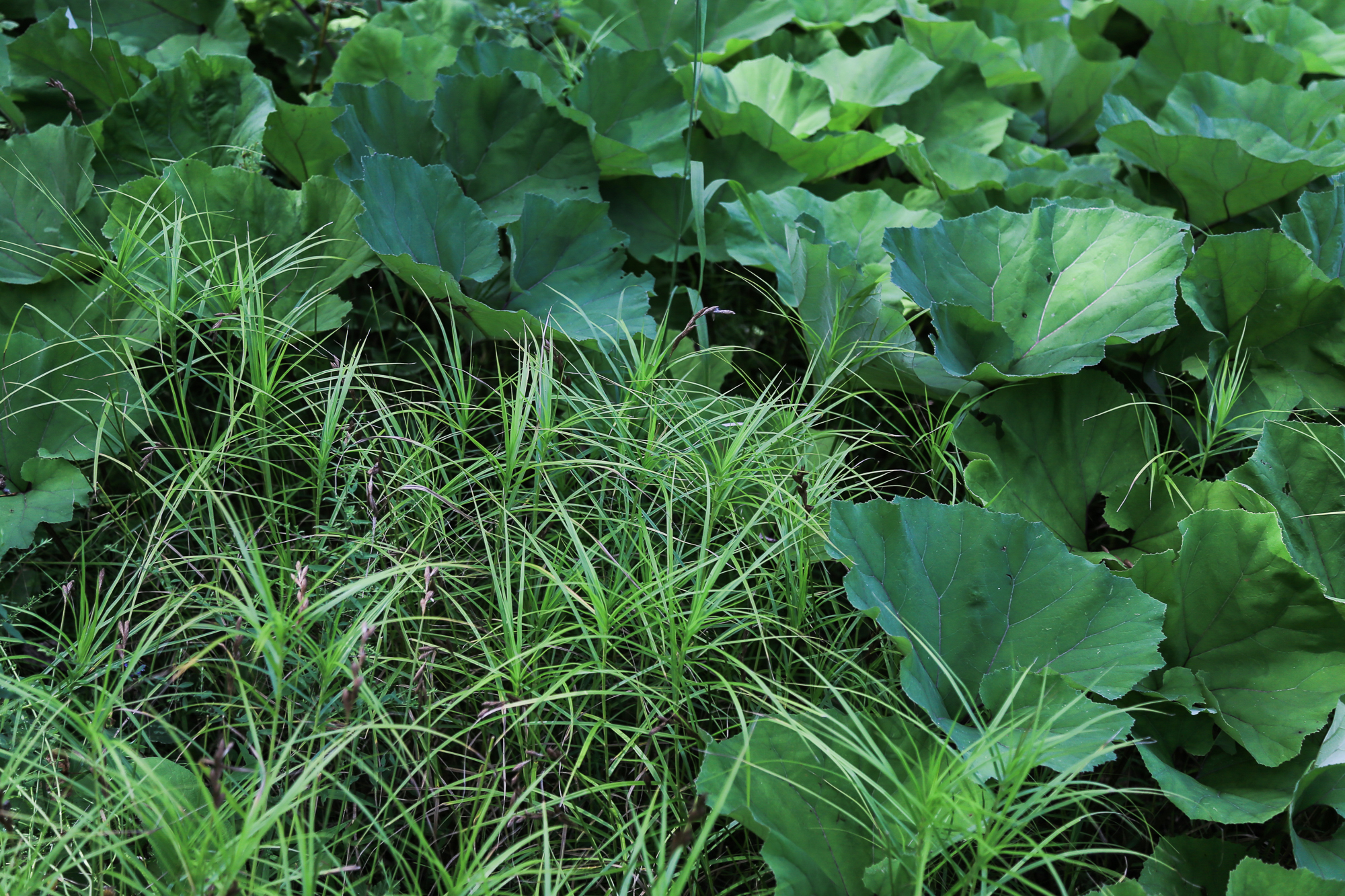 These plants--Carex muskingumensis 'Oehme' and Petasites x 'Dutch'--have been here almost from the beginning, and they are reminders that I have to select plants for function. I grow in unimproved, heavy, wet clay, so many common perennials simply die. Clay is rich, and it can promote weedy growth, so it's important to cover the ground with a thick layer of plants. My garden is only ten years old, but these stalwarts have been here from the beginning, performing their ground-covering function well, and beautifully. Of course, they were mail order plants too.
These plants--Carex muskingumensis 'Oehme' and Petasites x 'Dutch'--have been here almost from the beginning, and they are reminders that I have to select plants for function. I grow in unimproved, heavy, wet clay, so many common perennials simply die. Clay is rich, and it can promote weedy growth, so it's important to cover the ground with a thick layer of plants. My garden is only ten years old, but these stalwarts have been here from the beginning, performing their ground-covering function well, and beautifully. Of course, they were mail order plants too.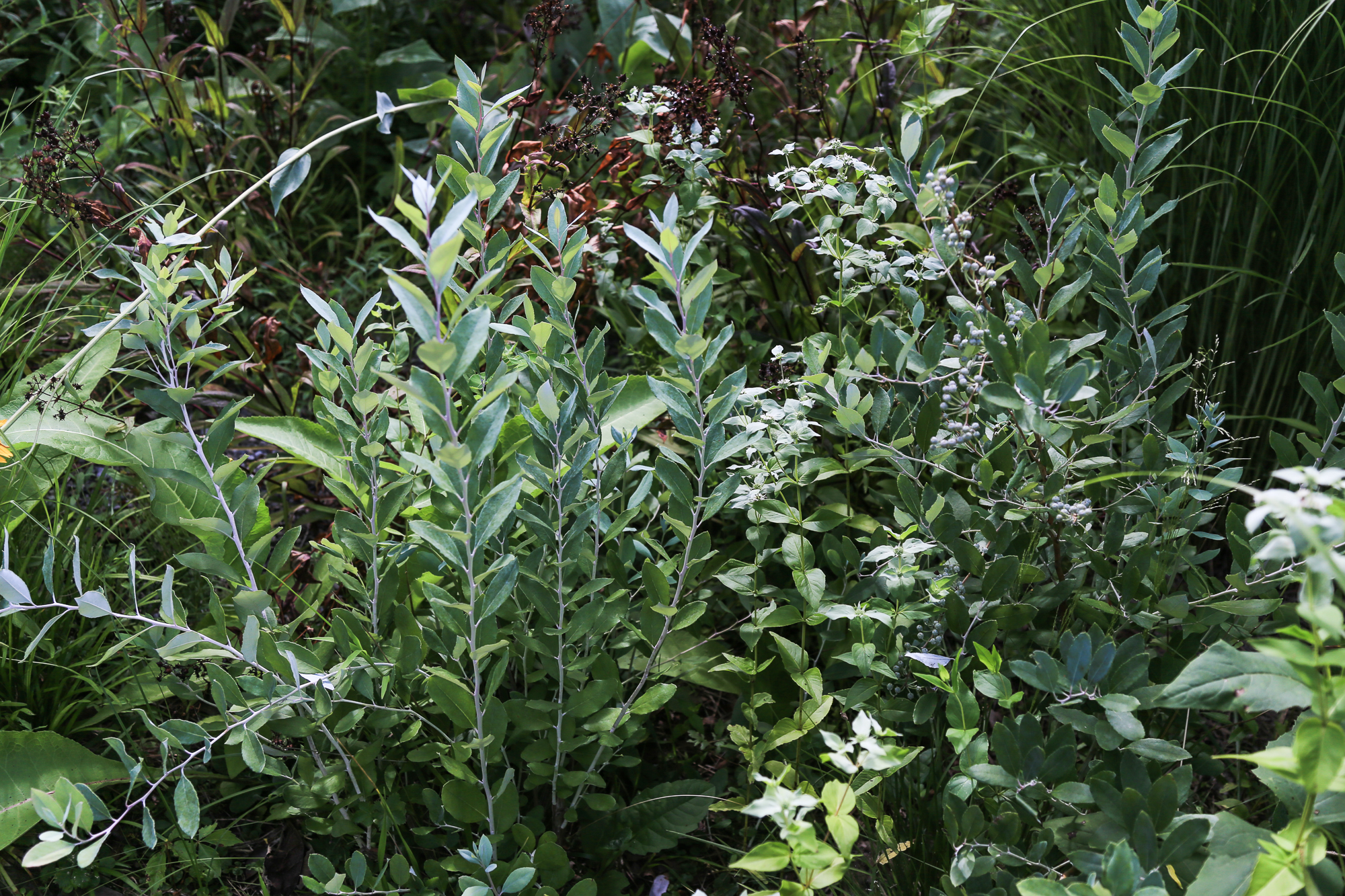 I'm not a rare plant collector--my concern is with the broad effects of the garden, its atmosphere, feelings, not with ditzy specimen plants--but I do prize these two Zenobia pulverulenta I found at the Millersville Native Plant sale several years ago. Its foliage is an extraordinary glaucous blue and I'd gladly have more but I've never seen another one for sale.
I'm not a rare plant collector--my concern is with the broad effects of the garden, its atmosphere, feelings, not with ditzy specimen plants--but I do prize these two Zenobia pulverulenta I found at the Millersville Native Plant sale several years ago. Its foliage is an extraordinary glaucous blue and I'd gladly have more but I've never seen another one for sale.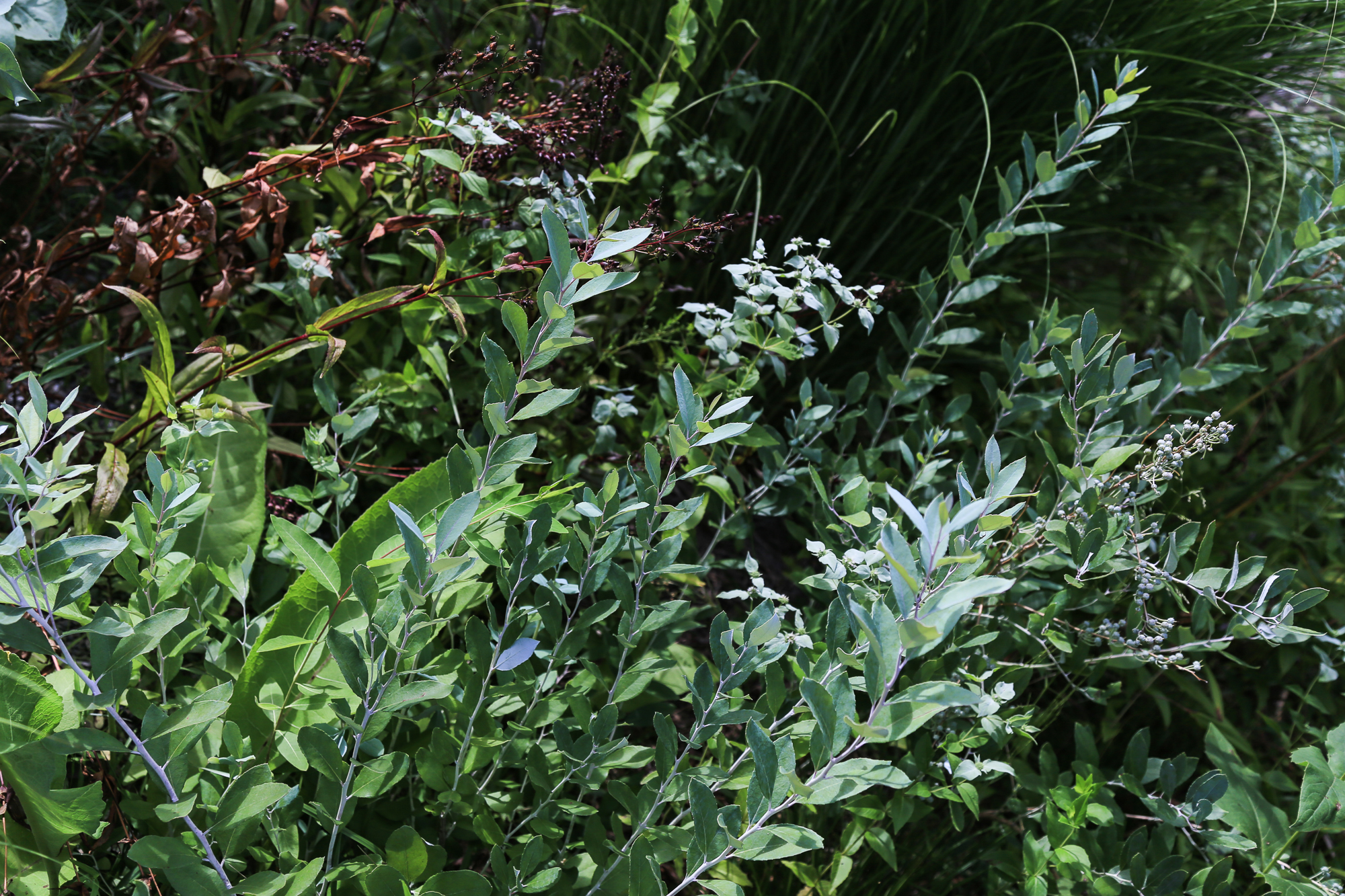 They add a remarkable complexity to the ground layer, especially if cut back every other year, which promotes fresh, new foliage color. They also give a blast of red in autumn.True to my blog's name, this post has really been a ramble, so I may as well finish it with another discontinuous thought. I love pollarded willows. This is a pollarded Salix alba 'Britzensis' started from a cutting several years ago. Though cut back to the main stem only two months ago, it's grown into a giant, elevated ball of foliage. It's true value will come in late winter and spring when the bark begins to glow orange. I've started several more as non-floral ornaments that will brighten the winter garden.
They add a remarkable complexity to the ground layer, especially if cut back every other year, which promotes fresh, new foliage color. They also give a blast of red in autumn.True to my blog's name, this post has really been a ramble, so I may as well finish it with another discontinuous thought. I love pollarded willows. This is a pollarded Salix alba 'Britzensis' started from a cutting several years ago. Though cut back to the main stem only two months ago, it's grown into a giant, elevated ball of foliage. It's true value will come in late winter and spring when the bark begins to glow orange. I've started several more as non-floral ornaments that will brighten the winter garden.